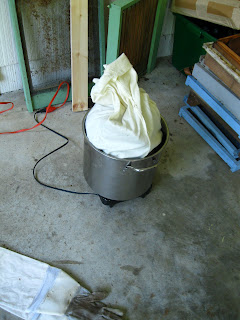Here is Gina getting all miked-up before the filming begins.

Allen comes with amazing equipment - microphones, cameras, and lots and lots of expertise!

The first part of the movie is to film taking honey off of the hive without using any chemicals like Bee Quik or Bee Go. As followers of this blog know, I don't advocate the use of any poisons, so I just shake the bees off and carry the frames away from the hive.

Allen is filming me putting the harvested frames into a nuc box to carry inside. The nuc is at my feet covered with a towel to keep interested bees from exploring the honey I am harvesting.

We took two frames in from Gina's hives. I had brought three frames of my honey from home. Here is one of the frames before a hard shake to get the bees off.
This is our last snapshot. We then got deeply involved in the bee movie. Gina showed how to use an extractor and then I did crush and strain. We bottled a couple of bottles of honey. I thought my honey was awfully thin.
I took my honey bucket home to bottle the rest. I kept thinking the honey was really thin. I decided to put a drop on the refractometer. This was fully capped honey and I have not been feeding my bees sugar syrup this entire season. To my horror, the moisture level was 20.2. Honey is too moist above 18.6 so this was honey with way too much moisture.
I've always relied on taking fully capped honey, believing that the bees don't cap honey that is so moist that it will ferment. Well, not so this time. I called Cindy Bee who told me to put the bucket with a dehumidifier and maybe it could be de-moisturized enough. I posted on Beemaster to find out what people thought was behind this. One theory was that we are in a heavily humid area and maybe the bees just quit before they evaporated the moisture because it has been humid and rainy. Who knows?
Maybe I should make mead.......that way the inevitable fermenting is invited!
















































